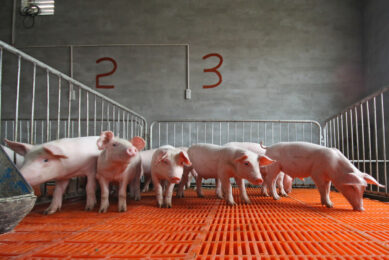Feeding under heat stress
During the summer months, heat stress markedly reduces feed intake in lactating sows and fast-growing pigs. Below is a quick summary of the most important strategies, used around the world, to tackle that problem.
By Ioannis Mavromichalis, PhD, Nutral, Madrid, Spain
Pigs reduce feed intake when under heat stress in an effort to curb generation of internal heat from digestion and metabolism of feed. Nutritional intervention strategies to overcome low feed intake during the summer months aim to either sustain daily nutrient uptake by increasing diet nutrient density or to reduce generation of feed-related heat by altering the source and level of key nutrients.
Increase nutrient density
It is generally assumed that daily nutrient uptake can be maintained during the summer months if nutrient density increases proportionally to the expected reduction in feed intake. For example, if feed intake is expected to drop by 10%, then all nutrients (including vitamins, minerals, and trace minerals) should be increased by 10% to compensate for the reduction in feed intake. For several nutrients, however, there are manufacturing limits that may restrict the application of this strategy. For example, it is not always practical to add more than 6 to 8% fat in commercial diets. Also, the concentration of certain additives cannot be altered due to countryspecific regulations. Therefore, this strategy is always combined with another one to increase response.
Reduce excess protein
Excess protein is deaminated and excreted in the form of urea. This process also generates heat. To this end, it is recommended to reduce dietary protein concentration by circa 2% with the aid of crystalline amino acids. Further reductions in dietary protein are either economically unfeasible or result in diets limiting in valine and isoleucine.
Reduce fiber concentration
Fiber digestion and metabolism generates considerably more heat compared to carbohydrates, with fat and lipids generating the least amount of internal heat. Thus, a common measure to combat heat stress is to reduce dietary fiber by 1 to 3% (depending on initial concentration). Care should be taken for sows to be supplemented with a strong laxative (usually a salt) to compensate for the reduction in dietary fiber. The effects of fermentable and (or) insoluble fiber fractions on heat production remain unclear.
Increase use of fat calories
It appears that fats and lipids not only increase dietary density, but they also generate less heat during digestion and metabolism. Therefore, diets high(er) in fat and lipids are often recommended for combatting stress heat. However, it is always imperative to also increase (proportionally) the levels of all amino acids and other nutrients, to avoid unbalancing diets.
Add sodium bicarbonate
Research and experience have clearly demonstrated that adding 5 to 10 kg of sodium bicarbonate per metric tonne of complete feed, improves feed intake in lactating sows. It has also been shown that sodium bicarbonate reduces backfat thickness in finishing pigs, so this should be taken into account when feeding pigs in markets desiring an above average fat coverage.
Pelleted diets
Pelleting diets increases physical density resulting in higher uptake of nutrients at a given volume of feed. Combined with increased nutrient density, these two strategies help markedly in sustaining daily nutrient intake during heat stress.
Liquid diets
One of the major benefits of liquid feeding is that sows and growingfinishing pigs sustain higher feed intakes during the summer months. Perhaps, the increased intake of water enables them to control better their internal temperature.
Extra vitamins
In other monogastric species, additional vitamins (vitamin C) have been shown to help animals under heat stress. Such effects are not well documented with pigs, but they definitely merit further investigation.
Cool water
It has been shown that pigs provided with cool(er) water during periods of heat stress are able to sustain better their growth performance. In addition, pigs offered cool(er) water consumed less water per day, indicating that cool(er) water enabled pigs to quickly adjust their body temperature in response to heat stress.











